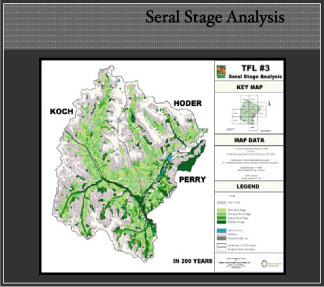Landscape-Unit Analysis
Priority Biodiversity Planning
Landscape-unit planning in British Columbia presently emphasizes biodiversity management. With the focus on retaining old-growth forest and on maintaining stand structure through wildlife tree retention (priority biodiversity planning), forest managers are presented with the challenge of establishing old-growth management areas as the most important component in conserving biological diversity.

Forest Ecosystem Solutions Ltd.'s proprietary modeling tool, FSOS, will guide forest managers in finding answers to such landscape-unit planning questions as:
- How do we decide where the old-growth management areas should go in the landscape?
- Do we know where the old growth or recruitment areas are located now?
- Where will they be in 20, 50, or 100 years from now?
- Would the use of different management strategies result in different spatial opportunities in locating old-growth management areas?
FSOS tracks old-growth (and other seral stage) targets for each biogeo-climatic variant and landscape unit. Because all the results are spatial, it is possible to "see" where the old growth is and whether it is contiguous at any time throughout the planning horizon for any number of management scenarios. Results allow for tradeoff analyses between competing candidate OGMA areas.
- What are the effects of old-growth management on timber supply?
Unlike other models, FSOS can assess the impact of spatially established old-growth management areas, not only at the strategic level, but also at the tactical level. With the assistance of the SYSTEM, planning for old-growth management areas and forest operations simultaneously becomes a straightforward process, with little risk of underestimating the true impacts of permanent old-growth management areas. Existing, planned, short-term, operations can be included in the analysis.
Full Biodiversity Planning
Our FSOS is the perfect tool for helping forest managers in British Columbia deal with recently introduced requirements to complete landscape-unit objectives for seral stage distribution, patch size, connectivity, and other elements of biodiversity (full biodiversity planning).
Among the many challenges these requirements present to managers, Forest Ecosystem Solutions Ltd. will answer such landscape-unit planning questions as:
- How does one design harvesting operations and forest management in general, while attempting to meet specific seral-stage distributions and patch-size targets over decades, and in some cases centuries?
- Will different strategies produce different results?
FSOS works towards a user-defined future forest. It directs harvesting activities to meet seral-stage distribution targets and patch targets. It allows for testing the impacts of different strategies on seral-stage distributions and patch sizes.
